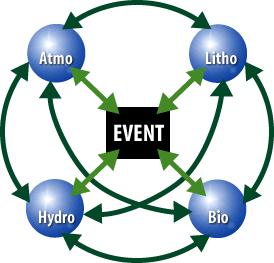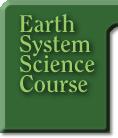Assessment
Overview
Week B: Teacher as Model Builder—Team
ESS
Model-Building
Assignment & Rubric
Weeks
5, 8, 11, and 14
Goal:
Using your team's original or revised problem statement, build
an ESS model that includes the ESS relationship statements
and evidence that support your conclusions (recommendations
or solutions).
Background:
Based on your collective knowledge and the answers to your
questions in Week A, create an ESS model as a team. Discuss
what you learned and what conclusions you can support with
evidence from multiple sources including observation, expert
opinion, analogy, or experimental results.
"Does
that make sense?" you ask. Negotiated meaning is at the
heart of developing meaning. We can memorize on our own, but
we need to talk or write about our ideas to refine them.
So how
does negotiated meaning work? Doesn't the loudest, oldest,
or smartest voice usually dominate? Isn't there a right answer?
Why should you entertain ideas you don't agree with? Consider
these three reasons:
- Some
say truth has its own life - that we have only to discover
it, so when the same idea emerges from different people's
thinking for different reasons, it often points toward the
truth.
- Language
gives life to thought and, in doing so, changes it. In a
team, your job is to be sure that you are understood. Is
what your teammates heard what you meant? Feedback from
them about what they heard pushes you to be clearer in your
communication and your thinking.
- Seeing
how ideas filter through other people's minds gives you
a perspective you can only imagine on your own. What ideas
do others find most compelling? Why? How do ideas fit together
for them? What do they find to be problematic? What are
they curious about? Tell them what you hear them saying
and do your best to understand what they mean. If you can
live inside their perspectives, they will expand your own.
Remember,
a model satisfies a broader audience than your own mind. The
evolution of private theories into models is the social learning
phenomenon that Vygotsky identified and is the outcome of
Problem-Based Learning. Building a model takes reflection
and dialectic. The trick is to stay curious rather than to
become judgmental and critical of others' ideas. When you
become judgmental and critical, you are probably hanging on
to those private theories a little too tenaciously.
Think
like an investigator, trying to discover, rather than deciding
what to think. Use your teammates to keep you honest about
the quality of your ideas and to expand your sense of the
possibilities.
Use the
directions below to complete your model-building assignment.
|
Assignment
(by midnight Sunday)
Posting
Instructions for steps 1-3
Go
to the Classroom.
Click
on the event name (Volcanoes, Coral Reefs, Tropical
Forests, Ozone, Global Change) you are studying
in this particular cycle to enter the appropriate
event classroom. Then click on the Teacher as Model
Builder graphic. |
1.
You and your team need to think in terms of an iterative,
or evolving, process regarding the gathering of information
as you move toward your findings (PBL Step 8). When
ideas begin to emerge several times in different discussions,
it is a sign that you are developing a shared understanding.
The focus of this team assignment is to build an ESS
model to support the problem statement you developed
in Week A.
2.
Continue gathering information to answer your teammates'
questions from the Week A team assignment with evidence
from experience, research, and reading to support or
refute the team's ideas. You and your team will gather,
organize, analyze, and interpret information from multiple
sources. Exchange ideas; think about solutions; weigh
alternatives; and consider the pros and cons of potential
courses of action (PBL Step 7). As new information comes
to light, analyze it for its reliability and usefulness
and also for its impact on the direction that the problem
is taking, as well as for its effect on the very nature
of the problem. Therefore, you may need to revise or
modify your problem statement (PBL Step 6).
3.
The ESS model that you build with your team should include:
-
Your team's findings as they relate to the problem
statement: a brief opening summary of supportable
ideas and conclusions (recommendations, solutions,
or alternatives) based on the information your team
has collected, particularly for your ESS analysis, over Weeks A and B (PBL Step 8).
-
Statements about the relationships: detailed accounts
of all the changes and impacts (revealing your understanding
of interrelationships of the spheres and the event in the Earth
System Diagram) that led your team to the conclusions
put forth in your recommendations or solutions (findings).
Make
sure you include the systemic relationships,
called causal chains, where multiple spheres and the event are involved in complex and interrelated
changes. In a system, nothing occurs in isolation.
Each causal chain should include S > S > S
interactions.
-
Evidence:
For evidence that your thinking is accurate, consider
information, examples, and corroboration from readings,
web sites, CD-ROMs, analogies, or experimental results
and experts. Combine these to give credence to your
relationship statements in the causal chains.
|

Rubric
Your team Week B: Teacher as Model Builder assignment
corresponds to PBL Steps 7 and 8. The rubric below assesses
how well you build a team model that supports your findings.
You can
earn as many as five points for this assignment. You will
automatically earn one point for submitting your assignment
on time. See the Time Rubric. Use
the criteria and indicators below to gauge your success in
earning the remaining four points.
| Rubric
Criteria:
Clarity
and focus of supportable ideas and conclusions
|
| 4
Rating:
Develop
a comprehensive summary of supportable ideas and conclusions
that go beyond the facts to show insight into the systemic
relationships. |
3
Rating:
Develop
an accurate summary of supportable ideas and conclusions
with insight beyond the facts.
|
2
Rating:
List
some supportable ideas and conclusions beyond the facts
that summarize the overall causes and effects. |
1
Rating:
List
ideas and conclusions, but does not summarize the overall
causes and effects or fails to go beyond the facts. |
| Rubric
Criteria:
Number,
accuracy, and thoroughness of relationship statements
(assertions) in casual chains |
| 4
Rating:
Reveal
a thorough understanding of the Earth System Diagram through
your analyses by asserting in full detail the impact of
the event on the spheres, the interactions among spheres,
and the return effect on the event itself in causal chains. |
3
Rating:
Reveal
a satisfactory understanding of the Earth System Diagram
through your analyses by detailing causal chains involving
all the spheres (at least S>S>S). |
2
Rating:
Reveal
some understanding of the Earth System Diagram through
defining causal chains and supporting them. |
1
Rating:
Show
some understanding of the Earth System Diagram through
your analysis by describing causal relationships. |
| Rubric
Criteria:
Scope,
detail and accuracy of the evidence supporting the relationship
statements |
| 4
Rating:
Present
comprehensive evidence or other corroborative data from
multiple sources that are thoughtfully explained for each
assertion. |
3
Rating:
Present
evidence to support most, but not all, of your relationship
statements, or present incomprehensive evidence to support
each assertion. |
2
Rating:
Present
some evidence to support most assertions. |
1
Rating:
Present
little or no evidence to support assertions. |
| Rubric
Criteria:
Team
members contribute insight used in the development of
the model. |
| 4
Rating:
Each
member of the team contributes insight beyond the facts
for the development of the model. |
3
Rating:
Each
member of the team contributes to the building of the
model, some with insight beyond the facts. |
2
Rating:
Each
member of the team contributes to the building of the
model, but not beyond the facts. |
1
Rating:
Most
members of the team contribute to the building of the
model, but not beyond the facts. |
[
Welcome ] [Earth's
Spheres] [ Earth System Science
] [ PBL Model ] [ Use
of Technology ] [ Science as Inquiry
] [ Participation ] [ Assessment
Overview ] [ Course Sections
]
[ Home ] Intro [ Guide
] [ Outline ] [ Classroom
]
HTML
code by Chris
Kreger
Maintained by ESSC
Team
Last updated August 11, 2000
Privacy
Statement and Copyright©
1997-2000 by Wheeling Jesuit University/NASA Classroom of the Future™. All
rights reserved.
|



